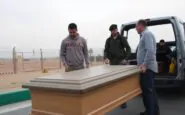Argomenti trattati
In the ongoing conflict between Hamas and Israel, the fragile truce has led to a series of complex exchanges, particularly concerning captives and their remains. Recently, Hamas has asserted that it is adhering to the terms of the ceasefire, while Israel’s actions, particularly regarding the Rafah border crossing, have raised significant concerns.
On a recent Tuesday, the transfer of remains of two Israeli captives was completed, highlighting the ongoing efforts to negotiate the terms of the ceasefire. The bodies of an elderly civilian, Aryeh Zalmanovich, and an army Master Sergeant, Tamir Adar, were returned to Israel, marking a poignant moment in this tense situation.
Exchanges of captives and remains
The International Committee of the Red Cross (ICRC) facilitated the handover of the remains, which were organized by the Qassam Brigades, the military wing of Hamas. According to the Israeli military, Zalmanovich passed away while in captivity on November 17, 2023, while Adar was killed during confrontations on October 7, 2023, and his body was subsequently taken to Gaza.
This exchange marks the latest in a series of efforts by Hamas to comply with the ceasefire agreement, having already returned the remains of 15 Israeli captives. The Palestinian group has indicated that approximately 13 additional sets of remains are expected to be transferred to Israel. However, the ongoing devastation in Gaza and the Israeli military’s presence in various areas are complicating the recovery efforts.
Humanitarian implications
In conjunction with these exchanges, Hamas has also released 20 living captives at the onset of the ceasefire. Simultaneously, the situation in Gaza remains dire, as evidenced by the return of 15 Palestinian bodies from Israeli detention. These remains were taken for identification at the Nasser Medical Complex, illustrating the ongoing human toll of the conflict.
As part of the ceasefire agreement, Israel has released around 2,000 living Palestinian detainees from its prisons and has pledged to return the remains of 360 deceased Palestinians. However, a forensic team noted that many of the bodies returned from Israeli custody exhibited signs of physical mistreatment, raising serious humanitarian concerns.
The Rafah border crossing dilemma
A critical issue at the heart of this conflict is the status of the Rafah border crossing. Hamas officials have expressed frustration over Israel’s refusal to reopen this essential gateway, which connects Gaza to Egypt. They argue that this closure hinders the movement of sick and injured individuals as well as the entry of much-needed humanitarian aid.
Mujahid Muhammad Darwish, leading the Hamas delegation in talks with Turkish officials in Qatar, emphasized the group’s commitment to the ceasefire despite what they describe as Israel’s repeated violations. They assert that the delay in reopening the Rafah crossing obstructs the fulfillment of humanitarian needs and exacerbates the suffering of the Palestinian people.
International responses and legal implications
The Rafah crossing has been closed since May 7, 2024, when Israeli forces launched an offensive in the region. The United Nations has characterized this crossing as one of the two vital channels for humanitarian access to the Palestinian territory. Despite an order from the International Court of Justice (ICJ) on May 24, 2024, mandating its reopening, the crossing remains largely inaccessible, with limited humanitarian access via the Karem Abu Salem crossing.
Residents of Rafah were only able to return to their devastated city after a temporary ceasefire on January 19, 2025, which allowed for some medical evacuations. However, new evacuation orders from Israel have once again complicated the situation, leaving residents in a precarious position.
As the situation continues to unfold, the international community remains watchful of these developments, hoping for a resolution that addresses the humanitarian needs of the people in Gaza while facilitating a lasting peace.

